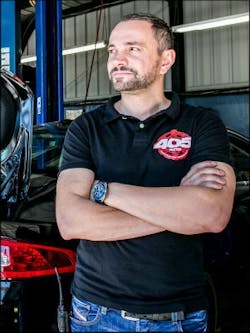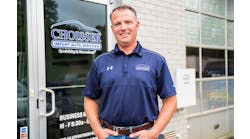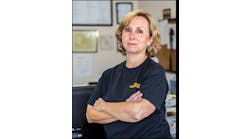She’s 89 years old, and Martin Kruszelnicki is eagerly waiting in the lobby this day in mid-2014 when one of his longest-standing customers came in to drop off her vehicle at 405 Auto.
This was a big day; “sort of a test of everything we were doing,” Kruszelnicki says.
So, let’s repeat this one more time: She’s 89 years old, and, in case you were wondering, yes, she still drives her own vehicle, every single day—including this day, when she pulled into Kruszelnicki’s Santa Monica, Calif., shop for some routine maintenance.
405 Auto is the epitome of the classic, local, independent repair shop—3,000 square feet, a handful of techs, an owner still working the front counter of what, from the outside, appears to be your run-of-the-mill facility; it’s a business built on a reputation of hard work, life lessons and the ingenuity of its owner.
But make no mistake, 405 Auto is anything but typical.
That’s why this day in 2014—and this 89-year-old customer—was so important to Kruszelnicki.
She walked through the glass front doors, crossed the marble floor of the small lobby, and came to the service desk where Kruszelnicki stood.
On the counter, there was nothing. No paper, no signs, no business cards, no pens. The only thing visible to the customer was a tablet device on a short, metal arm coming out of the front of the desk.
Kruszelnicki greeted her, and she instinctively turned the tablet and tapped the “Sign In” button on the screen. He watched as she entered her information, had her vehicle and repair history come on screen, and, through prompt after prompt, chose the purpose for her visit.
All the while, the two made small talk—about non-auto-repair topics.
“I was nervous about it,” Kruszelnicki says, “but when she was done, she said she loved it: ‘Oh, the font was nice and big; I could actually see it,’ she says. And if an 89-year-old customer had no trouble, then who would?”
The tablet is part of a sophisticated, yet intuitive, digital system Kruszelnicki has set up in his shop. The information the customer enters links to the shop’s database, which links to the vehicle’s repair history, which prompts the initial job in the management system, sends notifications to technicians, initiates the digital inspection process (also done on tablets), and builds the base for in-process customer communication and post-repair follow-up.
Welcome to your future; this is what the new auto repair industry looks like.
The American Dream Revived
Kruszelnicki was a car-obsessed engineer-in-training when he moved to America at 18 in 2001.
“I came to California for one reason: to work on the nicest cars in the world,” he says.
He opened his first shop that same year with just $1,500 in his pocket. As a one-man operation, Kruszelnicki slowly built his business, reinvesting back into the shop at every opportunity. He went after high-end customers, spent his profits on the latest tools and equipment and focused on taking care of the customer.
In 2005, he moved into his current facility—a former transmission shop on Olympic Boulevard, Santa Monica’s main thoroughfare that quietly weaves through the town before turning into Interstate 10 heading toward Los Angeles.
“We kept growing, little by little, and then 2009 and the recession came along,” he says. “There was an economic crisis, as well as a change [in culture] with the dependency on the Internet and smart phones. Everything was going in different directions.”
And so did the shop. Instead of hunkering down, Kruszelnicki doubled-down on his business model—he renovated the lobby with affordable yet elegant marble floors and bamboo walls with stainless steel accents; he joined a management training group; and he turned his eye toward technology.
“This is the way it was going. If you don’t go with it, you will lose the business, you will lose the battle,” he says.
In 2014, the shop did $1.4 million in revenue with a staggering average repair order above $1,400.
A Tour Through the New Industry
The automotive industry is advancing at a breakneck pace, say Chris Chesney, senior director of professional markets for Carquest. And to date, he says vehicle design and technology has progressed far quicker than the average business tasked with fixing those increasingly more sophisticated vehicles.
Chesney teaches a course based on the concept of the “shop of tomorrow,” and through his work at Carquest has worked with shop operators to upgrade their businesses to meet the demands of the modern industry.
Technology is the solution to fill the gap, he says. Many of the latest tools, equipment, concepts and processes that Chesney teaches are prevalent throughout 405 Auto—from customer check-in to the repair itself to the delivery of the vehicle and follow-up with the customer.
Although Kruszelnicki is proud of what he’s built, he doesn’t consider his efforts special; they’re simply necessary, he says. And it’s something every shop can do.
“We’re not a dealership with a big budget,” he says. “We have to save and plan the same as anyone. We’re still a small shop. We’ve just turned into something different.”
“It isn’t about fancy toys or showing off technology, it’s about using technology and devices to make it easier and simpler for customers, and for your shop,” he adds. “In the end, you provide a more transparent, comfortable relationship.”
The 405 Auto Process
Step 1: The Check-In
Let’s start with the right mindset here: “For customers, auto repair is a pain,” Kruszelnicki says. “Our goal should be to make it as painless as we can.” Everything, from start to finish, needs to be adapted to meet that goal.
For 405 Auto, that starts before the customer comes in with the shop’s website, 405auto.com. It’s not anything flashy; yet, it incorporates all the necessary components to successfully draw customers: (1) search-engine-optimized descriptive language at the top; (2) clearly display the shop’s reputation in the form of reviews; (3) a clear call to action, telling the potential customer what to do next; (4) a declaration of expertise; and (5) a value proposition in the form of the shop’s three-year, unlimited-mile warranty. The website also has (6) a repair update feature (more on that later), (7) an appointment scheduler, and (8) a pop-up screen that allows you to chat with the shop’s service advisor.
Once the customer is in the shop, though, is when Kruszelnicki’s technology really becomes apparent, none more obvious than the tablet-based Welcome Station. The system from Bolt On Technology fully syncs with a shop’s management system and allows customers to quickly enter in information that either begins a new-customer account or quickly brings up past repair history from previous visits. It collects all the information a shop needs for future customer contact both during and after the repair. Customers also enter in vehicle issues, and the system issues prompts that offer up-selling opportunities; a weather-linked feature, for instance, will ask about wiper blades if it is rainy that day.
Step 2: The Repair
Kruszelnicki knows the industry’s long-iffy reputation with the average consumer, and that’s what led to him to introduce in-process vehicle updates on the shop’s website. Kruszelnicki designed the feature himself through “some simple coding,” he says, and it is something other website designers can “easily incorporate without much work at all.”
It’s pretty simple: The customer enters in his or her VIN, and it takes the customer to a landing page that shows what (9) stage of repair the vehicle is in and (10) photos taken by the technicians during the repair. Kruszelnicki says it takes roughly 3–5 minutes for him or his staff to input the updates, which are done after each stage of the repair.
The simplicity of those updates comes from another tool the shop uses: tablets in the service bays. By spending roughly $1,000 on five Android-based devices, Kruszelnicki was able to equip his entire technician staff with tablets used for both the Mobile Manager Pro (also a Bolt On product) digital inspection application and for repair data look-up. The inspections are performed on every vehicle, uploaded into the shop’s management system (RO Writer) and can be directly emailed to the customer with attached photos.
Then, of course, there are the tools that go into actually diagnosing the vehicles. 405 Auto has more than 20 scan tools, ranging from OEM-specific products to smaller meters, scopes and smoke machines. The shop also has subscriptions to Mitchell1 ProDemand, ALLDATA and iATN.
And 405 Auto plays into its environmentally focused area by cornering its hybrid-repair market. The shop is a member of The Hybrid Shop program and has two technicians trained and focused on repair work on all hybrid and electric vehicles. The shop has a battery reconditioning tool and a secondary website under the name Santa Monica Hybrid through that program.
Step 3: The Delivery and Follow-Up
Everything Kruszelnicki has put into the repair process has been about convenience and building trust through transparency.
“If we’re being honest, [customers don’t want] to be here and they don’t want to have to worry about whether the work is correct or not or if they can trust you,” he says. “We want everything in front of them at all times when they want it.”
Because of the other processes in place, Kruszelnicki rarely sees customers between drop-off and pick-up. The shop sends updates through phone calls, emails or text messages, and they use the customer’s preferred method of contact to alert them when the job is finished.
Following the repair, Kruszelnicki uses his fully stocked database to keep in touch with his customers through direct mail and email marketing.
“It used to be really painful to get emails from people,” he says. “Since we’ve had the tablet [Welcome Station], we haven’t even had to ask anymore. People just enter it right in.”
Fighting the Tech Disconnect
Now back to that 89-year-old customer. Kruszelnicki says that she and all of his other customers have been proof that increased use in technology doesn’t hinder the personal experience with customers.
“The whole time she’s entering in information, we’re chatting,” he says. “We’re not talking about her car or anything. It’s building a relationship.”
Technology leads to increased efficiency, he explains, and that leads to more time actually spent taking care of the customer (or the vehicle) that otherwise could be spent doing paperwork.
“This is the way all businesses are going, and it’s better for everyone—the shop, customer,” he says. “People will always choose something that is easier and more convenient for them. We have to make our businesses that way. That’s the only way we have a future.”




